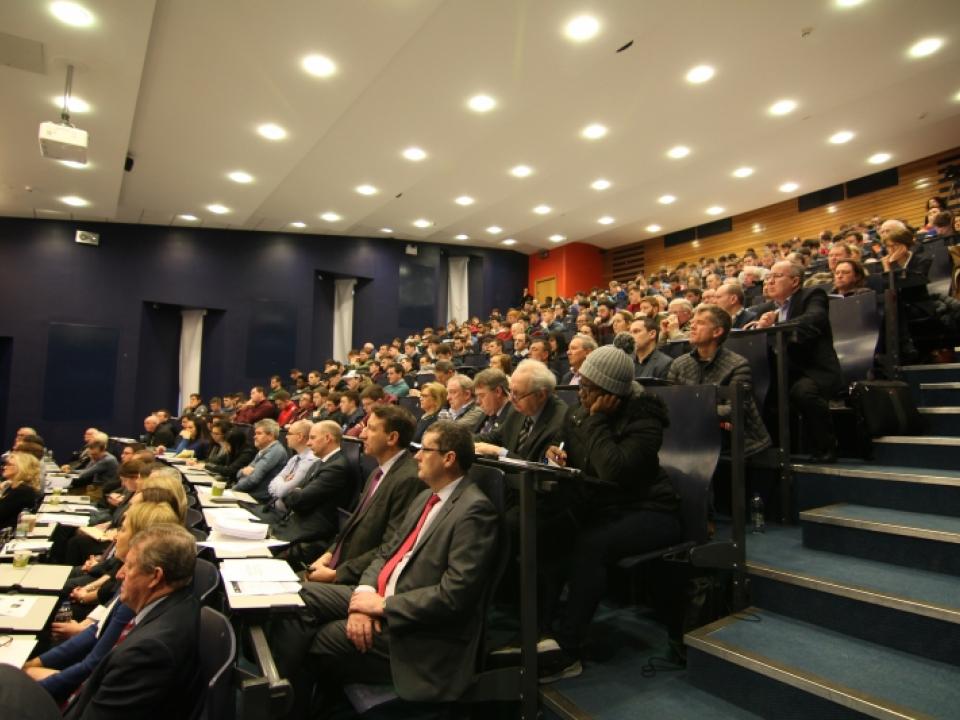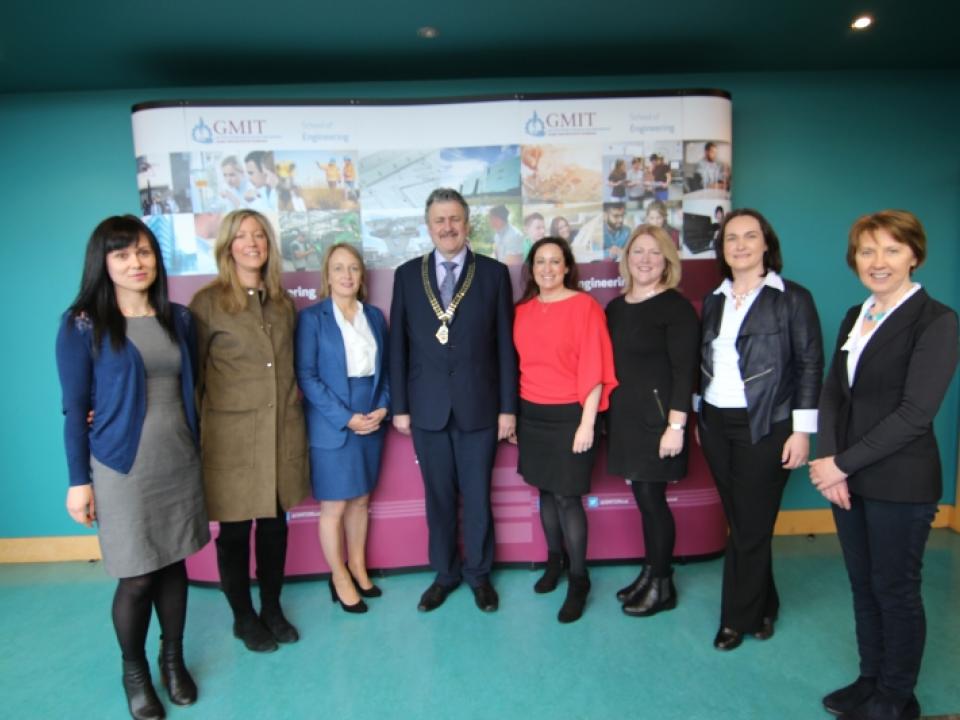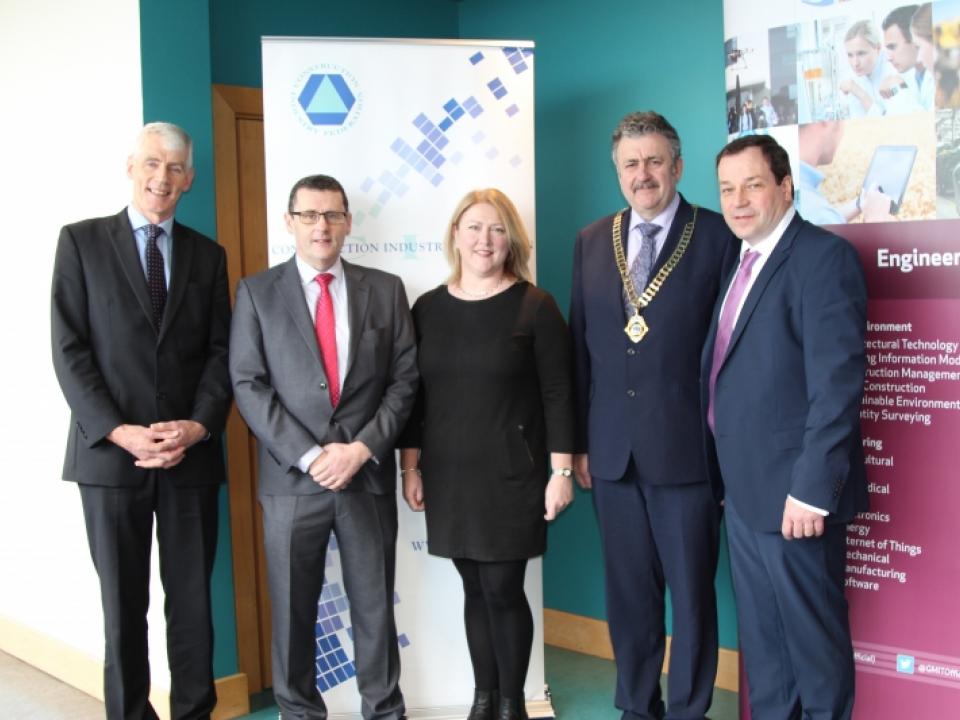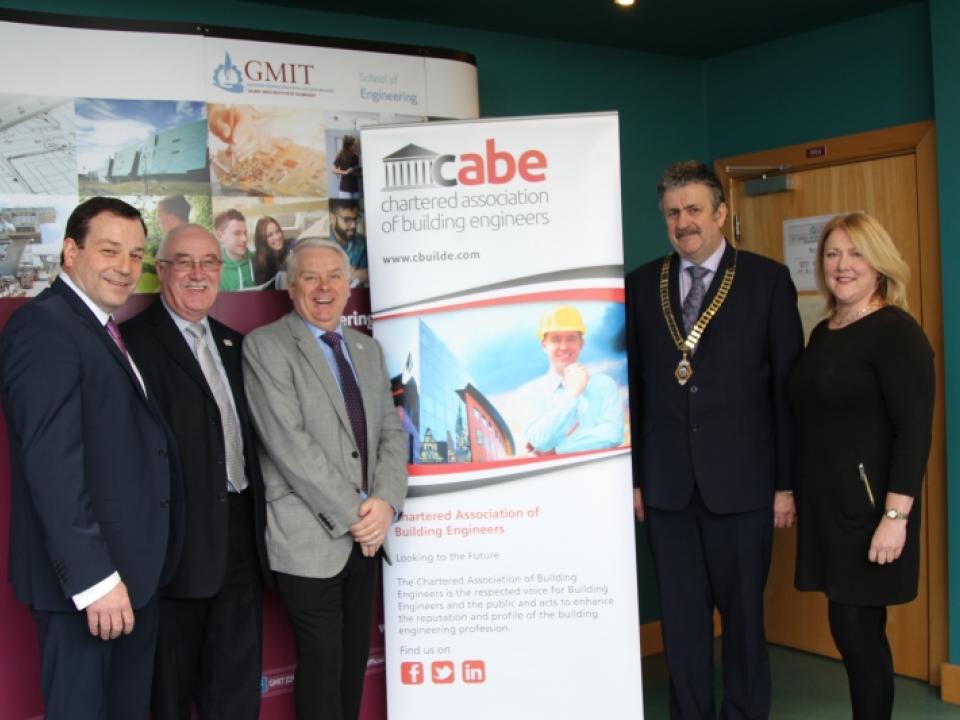Key messages from speakers at 8th International Construction Management Day Conference
An industry emerging from recession and starting to expand strongly
An industry emerging from recession and starting to expand strongly and an industry on the cusp of massive change, driven by digitalisation of design and process and the introduction of new technologies, were the key messages delivered at this year’s GMIT International Construction Management Day Conference in GMIT Galway on Tuesday, 6 March.
Several hundred delegates attended the event, hosted by the GMIT Department of Building & Civil Engineering.
GMIT President, Dr Fergal Barry, opening the conference, highlighted the deficit in third- level educational development funding during the recessionary years and the need for considerable construction/infrastructure funding both within the third-level sector and nationally; citing the need for 4,500 social houses in Galway alone. He welcomed the Government’s recently announced €116bn National Development Plan, Ireland 2040.
Dr Barry noted the significant increase in demand for construction related programmes within GMIT and nationally. He said meeting fee obligations was still a serious and ongoing issue for many students and he was not in agreement with the idea of student loans, given the extent of those from difficult socio-economic backgrounds. He provided an update on the Technical University development between GMIT, IT Sligo & Letterkenny IT and stated they were open to accepting other participants in the creation of a top class Technological University representing the western seaboard of Ireland.
Key messages from the speakers:
Tomás Kelly, Director of AECOM Ireland, highlighted the cyclical nature of the construction industry and the current upward part of high growth; 2017 construction output increased by 8% and he predicted output in 2018 would rise by 14%. In line with the recovery to date, the increases are not evenly distributed throughout the country with the greater Dublin area responsible for a large proportion or the growth.
Tomás summarised planning permission applications against floor area across the country, stating that residential development was responsible for 57% of planning applications and the Dublin region alone accounted for 42% of the overall floor area, for which planning permission was being sought.
Tomás shared survey results from the recently published AECOM report on ‘Drivers of Innovation’ in regard to improved cost, time and quality factors; drivers of innovation in regard to Building Information Modelling (BIM) and the main requirements for sustainable cities (water supply / space for growth / transportation / flooding buffers).
Construction inflation was also a particular concern. Tender prices are predicted to rise by 7.5% in 2018 in the greater Dublin area and 5% elsewhere. In line with other speakers, Tomás highlighted skills shortages as the biggest immediate challenge to the industry along with the need for infrastructural investment
Dominic Doheny, President of the Construction Industry Federation (CIF) and Joint Managing Director of John Flanagan Developments, highlighted the rollercoaster nature of the industry and outlined three possible scenarios for the industry over the next 20 to 30 years: repeating the mistakes of the past, in which case boom and bust would be repeated; repeating some successes of the past, leading to a mixed picture, and/or proceeding from here-on with ‘Smart Sustainable Growth’ achieved by government and industry collaboration. This would engender embracing innovations such as Lean Construction and Investment in BIM, he said, and would produce technology enabled growth while meeting Ireland’s climate change challenges head-on. Dominic foresaw a future vision where Irish construction firms could compete and challenge globally not just nationally.
Dominic sees significant challenges to this proposition that will have to be overcome. These include the current skills shortage, which has seen a lack of young people entering the industry, both at managerial/technical levels and also in the trades. Another challenge is making the industry one that either gender considers viable; at present the industry has a marked lack of diversity, further exasperating skills shortages, he says. Greater government investment in construction related research and development (citing, in comparison, substantial government investment in the food industry research as an example), replacement of skills lost by Local Authorities during recession and breaking the emphasis on ‘lowest price’ as against ‘value’ are also seen as significant challenges.
David Taylor, President of the Chartered Association of Building Engineers (CABE), is an Architectural Technologist and has run a highly successful consultancy business in the UK, for over 25 years. David looked at how construction will evolve over the next 25 years. He views the major industry challenges as being lack of investment and the need to embrace technology to drive change; he sees BIM as a game-changer, capable of de-risking construction and making it faster, cheaper and engendering better quality.
David outlined a number of technologies that will radically change construction in the near future. These included: modular / off-site construction, whereby work which was traditionally constructed on the work site, would now be factory made and installed on site as components. Off-site manufacturing has been around for many years but has not yet made the breakthroughs predicted. David feels this will change shortly, partially driven by BIM. Virtual Reality (VR) and Augmented Reality (AR) was also discussed. This technology enables clients and others to ‘live’ walk through digital models of buildings before they ever start on site, enabling costly changes, at a late stage, to be avoided. This technology is already available and starting to be used in the industry. A full demonstration of VR also took place in the conference exhibition area. David also discussed the use of drones, which he already uses in his business. These are capable of scanning large areas from which digital models can be produced. Survey work that once took weeks, can now be achieved in days or hours. David also explored the potential of: 3D printing of buildings; Nano technology; Construction robotics (including SAM the bricklaying robot); Exoskeleton suits; smart site helmets and Artificial Intelligence.
Brian McIntyre, from the Sustainable Energy Authority of Ireland (SEAI) provided an outline of the Deep Retrofit towards Zero Energy Programme that commenced in June 2017. It is estimated that up to one million existing homes in Ireland are considered to be significantly energy inefficient resulting in higher energy bills and poorer health and wellbeing for homeowners and occupants. The SEAI are working with the HSE to determine the health impacts of upgrading dwellings to an energy efficient standard i.e. Building Energy Rating (BER) of A3. Brian stressed the importance of pre-works assessment and design, engagement with stakeholders and technical issues such as minimising thermal bridging, providing a continuous insulation layer where feasible, the appropriate use of heat pump technology and mechanical ventilation systems.
Under the 2017 Programme, 42 homes received up to 50% funding of the total retrofit costs with initial results indicating a significant improvement in energy performance i.e. reducing average energy use from 465 kWhrs/m2/hr to 54 kWhrs/m2/hr and air permeability from 8.80 m3/hr/m2 to 4.31 m3/hr/m2. This has resulted in total energy and carbon reductions of 24,010 kWhrs/m2/year and 6,963 kg/year with associated cost savings of €1.95 per kWhr.
Eamonn Smyth, advisor to the Department of Housing, Planning and Local Government on Building Regulations, provided an entertaining overview of the upcoming changes to Technical Guidance Documents Part B (Fire) and Part L (Energy Performance). Technical Guidance Document Part B for Fire is split into two documents, one for ‘dwelling houses’ and one for ‘buildings other than dwelling houses’. Mr. Smyth noted that 80% of fires occur in dwelling houses. The updated document for ‘dwelling houses’ added in several new sections (B6 to B11) to the existing document and introduced a new classification for ‘community dwelling houses’. Mr. Smyth was also involved in the preparation of a new guidance document to address fire safety in this new classification of ‘community dwelling houses’ (see https://www.housing.gov.ie/sites/default/files/attachments/fire_safety_in_community_dwelling_houses.pdf. He intimated that the revised guidance document for ‘buildings other than dwellings’ will be sent out for consultation by the end of 2018 with publication sometime in 2019.
Oliver Mahon, Senior Vice President CRH Ireland and Spain, and a graduate of GMIT, gave a presentation on 'CRH and Future Developments in Material Supply and Technologies’. He explained how CRH grew, firstly from the merger of two Irish owned companies, followed by the further acquisition of other suitable companies, to become one of the largest construction material supply companies in the world, involving heavyside construction material, lightside products and building material distribution. Mr. Mahon also discussed future developments, such as how technology is accelerating and moving on in a shorter timeframe and how this is also bringing with it the potential damaging risks of technology disruption, for example hacking of computer systems. He discussed the increasing level of trade across the world and how the future global growth will increase. He described the changing landscape of the construction sector as a result of regulations, carbon emissions and waste and how this has resulted in the rising cost of sustainable construction. Mr Mahon outlined how CRH have to be innovative and to move with the trends or lose market position, while providing solutions for their customers.
Patrick King, Building Information Modelling (BIM) Director at ECD Architects gave a very informative presentation on embedding BIM into the organisational structures and working practices of Westminster Council in the UK. Mr. King outlined the steps that his own organisation, ECD Architects have undergone to initiative a BIM transformation within their working practices over the past few years, which involved significant investment in training and upskilling. The embedding of BIM within the fabric of Westminster Council went through several phases to identify current working practices and engage with the various stakeholders involved. This included: preparation and dissemination of draft templates to industry stakeholders for feedback; a series of collaborative workshops to identify barriers and opportunities; and the selection of pilot case studies to test out BIM protocols and organisational structures. The process is ongoing with a number of BIM Level 2 projects currently underway. Westminster Council is also proposing to require the submission of REVIT models as part of the planning process in the near future.
Patricia Calleary, Senior Inspector with An Bord Pleanála, gave a presentation on Planning and Flood Risk and explained that floods are a natural and inevitable part of life in Ireland. She outlined the ‘starkness of flooding’ by using powerful images of flooding in Crossmolina, Co. Mayo in 2015 and its dry river bed in 2016. Ms Cleary also provided a full and comprehensive description of the EU Floods Directive and the requirements of undertaking Preliminary Flood Risk Assessments (PFRA). She commended the works been carried out by the OPW in relation to the Catchment Flood Risk Assessment and Management (CFRAM) Programme and the National Flood Hazard Mapping website. She discussed the Planning System and Flood Risk Management 2009 under S.28 Planning and Development (Amendment) Act 2010, which have to be taken into account by Local Authorities for development plans. Ms Cleary also stressed that although good risk management is carried out, there are uncertainties with flood risk and that it is an inexact science of which climate change will have an impact.
Gus McCarthy, Director and Senior Planner with McCarthy Keville O’Sullivan Planning Consultants spoke about the Irish Planning System. He firstly referenced statistics provided by Tomás Kelly (AECOM), which indicated that planning was one area of the construction sector which is not fit for purpose and in need of a major overhaul, using the Apple, Athenry potential project as an example. He described in detail Project Ireland 2040. He enthusiastically explained the new planning and development regulations, judicial reviews and strategic housing development regulations; while clarifying their challenges for implementation and fast-tracking planning. While Mr McCarthy welcomes the introduction of these regulations, he made clear that they are falling short of what they were set out to do, in terms of accelerating the planning process for the delivery of additional housing stock and infrastructural projects, but added that it will get better and improve in time.
Mattie Dwane, Procurement Director at Specialist Project Services Ltd. and Project Procurement Manager for Alexion Pharmaceuticals presented an overview of ‘Lean Construction Ireland and Lean Contracts Initiative’. Lean Construction Ireland (LCI), established in March 2014 are an all island, independent and voluntary not for profit association who believe that Lean Thinking & Practices can enable and sustain enhanced effectiveness, efficiency, productivity and profitability in the Irish Construction Industry. LCI lead a community of learning and practice that promotes the application of Lean Thinking & Practices in the Irish Construction Sector so as to realise added value to all stake holders. The core values of LCI are collaboration, leadership, teamwork, commitment, knowledge, innovation and integrity. The vision of LCI is for projects to be delivered better, faster and together. Essentially, adoption of a joined up and collaborative approach.
The Lean in Contracts initiative was identified as a priority by members of LCI recognising that a need for contracts that enable and promote a Lean Construction approach, enable greater productivity, reduce disputes, reduce waste, reduce time over-runs, are more collaborative and provide for better project outcomes for all parties. Within LCI a cross industry sub-team from Academia, Engineering, Public Sector, Contractors & Clients examined the current state and desired future state of Lean in Contracts and conducted a gap analysis identifying near term and longer-term actions to deliver a future state contract that engenders Lean, between 2017 and 2020. The Lean Construction Ireland Conference in November 2018 will have a “Lean in Contracts” stream providing more information. For further information the LCI website www.leanconstructionireland.ie
Urszula Jedrol, BIM Manager, Stewart Construction and GMIT Architectural Technology graduate presented a ‘Case Study in Building Information Modelling’. Stewart Construction are a family run business established in 1902, and are a BIM enabled contractor. Urszula focused on Dublin Airport Central Phase 1, which is a Design & Build Contact and is a BIM Level 2 project for her case study. It consists of demolition of existing annex buildings and construction of two new office blocks and associated works. The project value is €45 million, and is a 20,000 m2 size project. Stewart Construction collaborated with an external design team to produce tender submission.
The BEP and all BIM Level 2 supporting documentation was produced in house by Stewart Construction. Synchro PRO was used to display construction timeline simulation. High quality visualisations were created to support the tender submission. A detailed plan was generated for maximising BIM for Facilities Management. A Common Data Environment (CDE) was selected to comply with BIM Level 2.
Kevin Duke, Managing Director, Duke McCaffrey Construction Consultants presented on ‘Current Issues and Concerns Affecting the Surveying Profession’ The RIAI forms of building contract, namely the yellow form (re-measurable) and blue form (fixed price) have been updated to RIAI 2017 edition, incorporating edits into the RIAI 2012 editions. The main changes to the contracts are that the Articles of Agreement incorporate a new fifth article regarding notice requirements, particularly regarding payment claims notices, under the Construction Contracts Act (2013). The summary of changes to the Clauses are as follows: Clause 1 – ‘Definitions’ contains an additional definition of the “Works” in response to changes in the Building Control regulatory environment and clarification re periods for delivery of notices. Clause 35 – Payments and Certificates, has been amended to align with the provisions of the Construction Contracts Act (CCA) (2013). Clause 38 – Dispute Resolution, has been retitled ‘Avoiding and Resolving Disputes’ and has been redrafted. The text has been modified throughout the contract in order to express gender neutral wording.
The Appendix to the Contract now requires the Architect’s email address for the service of payment claims notices. Default Period for Interim Certificates now one month – previously 4 weeks; aligns with CCA payment provisions.
The Sectoral Employment Order (Construction Section) 2017, took effect from 19th October 2017, it replaces the Registered Employment Agreements withdrawn in May 2013. The main provisions are that it outlines definitions for sector and categorises workers, sets out new basic hourly rates of pay, provides for unsocial hours payments, sets terms for pension schemes, sets terms for sick pay schemes and outlines a dispute resolution procedure.
The Construction Contract Act 2013 came into effect 26th July 2016 introducing mandatory payment provisions, formalisation of payment claims, timelines for payments, ‘Pay when Paid’ conditions are now prohibited, statutory entitlement to suspend work for non-payment, fast track dispute resolution procedures, binding resolution immediate and up-front and referral to Arbitration or Courts does not undo or stop decision enactment. The SCSI issued an Information Paper in March 2017, Quantity Surveyors Guide to the Construction Contracts Act so that members have a succinct guide and provide clarity on some aspects of the administration and management of the payment process.
Construction Cost / Tender Price Levels were discussed by Kevin, noting a trend for rising tender prices of 6 to 7% pa. Contractors are advising that there are many supply issues facing the sector. Steelwork is difficult to resource with suppliers having limited capacity, there is also a shortage of facade suppliers. Supply issues with joinery, plastering, partitions, blockwork / brickwork are now also being reported. A lack of labour and supervision resources, with Professionals, such as Architects, Engineers and Quantity Surveyors is also emerging.
Construction Insolvency remains a live concern for the Industry. Kevin’s presentation identified some of the many warning signs for Construction Insolvency such as: inflated applications, inflated variation claims, unfounded/optimistic delay, disruption or loss and expense claims, falling behind cash flow, claims for material deposits/off site materials, changes in sub-contractors, changes in suppliers, slowdown in activity on site, slowdown in material deliveries, lack of materials on site, changes in site management and head office personnel and risk adverse strategies being adopted.
Residential Construction Costs were the final topic of the day. Kevin highlighted how the supply of new residential stock was running behind current and projected demand. The SCSI undertook detailed research of real cost of development in the current regulatory, statutory and market environment. Research found that the construction costs account for 43 to 45% of the cost of development. The balance of costs were expended for fees, finance, levies and sales costs. The research also found the viability of a two-bed apartment of either low or medium rise in both urban and suburban locations are not viable when aligned with the potential sales price of the unit.
Copies of Presentations can be found here:
http://www.gmit.ie/general/constructgmit18-presentations
To join the Conference Mailing List for next year email:
martin.taggart@gmit.ie
About the GMIT Conference:
The conference was initiated in the depths of the recent economic troubles in 2010. At that time, the future of the construction industry looked bleak, with many household industry names going bust. At that time GMIT wanted to provide a forum where the industry could discuss a sustainable future for the industry. The first conference was held in March 2011 and was supported by The Chartered Institute of Building and the Construction Industry Federation. In subsequent years, The Society of Chartered Surveyors Ireland and The Chartered Association of Building Engineers, joined CIOB and CIF as the principal sponsors of the conference.
From small beginnings, the conference has now evolved into the largest annual construction event in the west of Ireland. It is a must attend event for people in the wider construction community. Senior students from GMIT programmes in Construction Management; Quantity Surveying and Building Economics; Civil Engineering and Architectural Technology, also attend the conference.
Fast forward eight years and the 8th annual conference heard a very different story, about the prospects and future evolution of the industry. A core theme of an industry emerging from recession and starting to expand strongly, was confirmed by all speakers. They also noted that the industry was on the cusp of massive change, driven by digitalisation of design and process and the introduction of new technologies.



